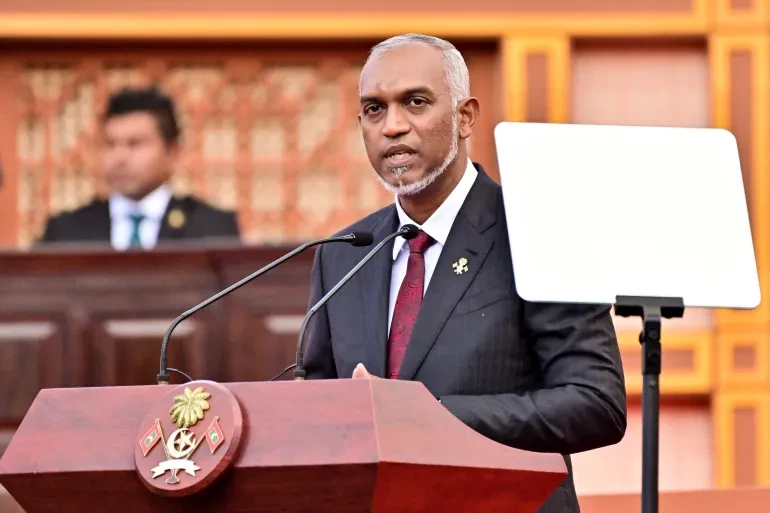
The recent events in India-Maldives bilateral relationship have taken a turn that can potentially disrupt some long-term objectives of the decades old partnership between the two countries. These tides however in India-Maldives ties must not be seen as one that should remain disrupted for short-term gains, especially within Indian political circles.
The escalation in the bilateral relationship began with the election of the current President of Maldives, Mohamed Muizzu who won the election based on his ‘India Out’ campaign. Under Muizzu’s regime, collaboration and cooperation with India in terms of bilateral engagements have significantly reduced. Nevertheless, a greater worry for the Maldivian population and policymakers should be the tilt towards Beijing that the current government in Male has showcased.
In the President of Maldives recent visit to Beijing this month, an approximate of 20 agreements were signed including the announcement of elevating bilateral ties to a comprehensive strategic cooperative partnership. Among such agreements deals to enhance the completion of projects under the BRI and other developmental projects were also signed showcasing Maldives re-orientation away from New Delhi to Beijing. However, by seeking greater tourist participation from China, not only is Male playing into Chinese hands, but is also falling into the same debt-trap that other countries in South Asia have faced.
In case of the Maldives, it seems to be following on Beijing’s direction on various other matters also for the moment. The government’s endorsement of the One China policy recognizing only one China led by the Government of the People’s Republic of China during the declaration of the Taiwan election too signifies how deeply Beijing now influences Maldives foreign policy too.
Within the larger ambit of South Asia, Beijing has been attempting to make greater inroads through its development finance as well as other techniques that have disrupted the independence of governments in the region. Development finance for one, has been Beijing’s go to leverage to bring in other partners under its own sphere of influence.
To begin with, the Belt and Road Initiative, bilateral development projects as well as some white elephant projects (initiatives that do not bring in the projected returns) are a few avenues through which China has made significant strides into South Asia’s political economy.
These development initiatives, that seem to showcase a vision of development, has in turn also led to detrimental economic experiences. In Sri Lanka’s case for instance, the development finance turned out to be disastrous for its economy. Moreover, apart from driving Colombo’s economy into recession in 2021, Beijing repeatedly refused to help the Lankan government secure international loans by denying to extend it relief in the bilateral lending’s that Sri Lanka had undertaken from China.
Sri Lanka up until 2020 had borrowed up to 4.6 billion dollars, over and above a loan of $500 million in both 2020 and 2021 each in order to ease off the strain on the island’s foreign reserves. The two countries also signed a currency swap deal of $1.5 billion in 2021. Yet, as the president of Sri Lanka himself claimed, Beijing had responded negatively for a 1.5 billion dollars credit line that it had agreed over a year ago.
- China asserts dominance and intensifies surveillance in Tibet
- US Senate Introduces Legislation to Solidify Its Stand on Tibet-China Conflict
- Xi Jinping’s authoritarian rule is under question by its citizens: Report
- TikTok used for disinformation campaign in Taiwan
Keep Reading
The government’s call of seeking a $1 billion dollar loan to buy essential items for the country too was ignored in times of economic difficulties for the island nation. On the contrary, it was the government in New Delhi that facilitated the transfer of emergency funds from international organisations by presenting itself as a guarantor.
It is however not only Sri Lanka that paid the price for friendlier relations with Beijing, but the story remained consistent with other countries in the region as well.
Nepal for one, was a privy to a similar approach from China as well. Even though there are no BRI projects in Nepal undergoing at present, China’s assertive behaviour in the country has only increased.
The counterfactual presentation of the Pokhra airport as a BRI project by China caused serious criticism for the government of the day that had claimed no BRI project had begun in the country.
The Chinese ambassador’s unilateral decision to proclaim the airport as one built under the BRI, led many in the government scrambling for answers as well as responses to international players.
Moreover, the Chinese Communist Party (CCP) has also been making serious political interferences in Katmandu’s internal politics. This has not only raised serious doubts among various parties in the country but has also raised eyebrows in other countries as well.
Maldives thus must remain cautious in the tilt it is showcasing towards Beijing in the present, for China’s headways in the region has demonstrated an ulterior motive of demeaning and dictating upon crucial decision the country makes well within its sovereign rights.
The experiences of South Asian countries must serve as an example of the aggressive path Beijing undertakes to assert its own decisions. India too needs to play a maturer role in these circumstances preventing Maldives, wherever it can from seeking China as an alternative. It must ensure that these short-term political stand-offs do not deter the long-term objectives the relationship is underpinned upon.
Although, an unfavourable government in Maldives will certainly pose problems for New Delhi, it must however persist on continuing its development and people-centric aspirations in its engagement in the region and seek to stabilise the bilateral relationship in other avenues as well.







